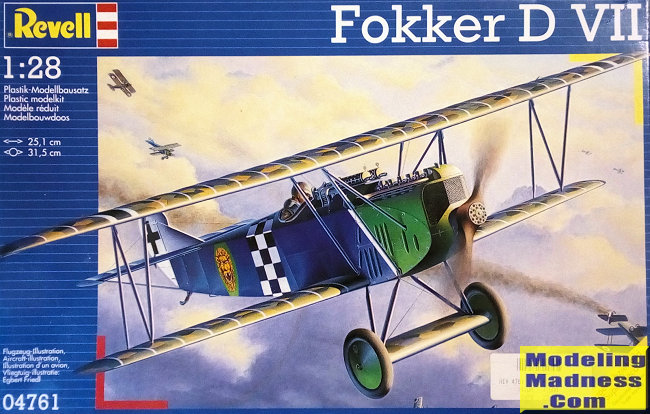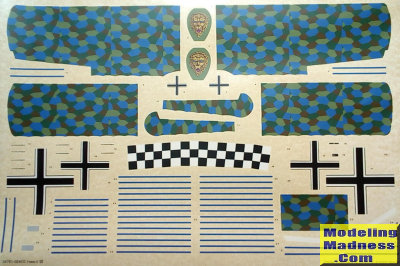
Revell 1/28 Fokker D.VII
| KIT #: | 04761 |
| PRICE: | €22 when new |
| DECALS: | One option |
| REVIEWER: | Spiros Pendedekas |
| NOTES: |

| HISTORY |
The Fokker D.VII was a German World War I fighter aircraft designed by Reinhold Platz of the Fokker-Flugzeugwerke. Germany produced around 3,300 D.VII aircraft in the second half of 1918. In service with the Luftstreitkräfte, the D.VII quickly proved itself to be a formidable aircraft. The Armistice ending the war specifically required, as the fourth clause of the "Clauses Relating to the Western Front", that Germany was required to surrender all D.VIIs to the Allies, with surviving aircraft seeing much service with many countries in the years after World War I.
| THE KIT |
 Revell
came in the mid 90s with a brand new mold D.VII in the unusual scale of 1/28
(possibly as a “match” to their old mold Fokker Dr.I). The specific copy was
discovered back in the early 00s, collecting dust in a toy/hobby shop and
carrying an attractive price. It comes at the usual Revell side opening blue
box, with a very attractive boxart of Lt. Franz Büchner being engaged in a
dogfight with his lavishly painted Fokker.
Revell
came in the mid 90s with a brand new mold D.VII in the unusual scale of 1/28
(possibly as a “match” to their old mold Fokker Dr.I). The specific copy was
discovered back in the early 00s, collecting dust in a toy/hobby shop and
carrying an attractive price. It comes at the usual Revell side opening blue
box, with a very attractive boxart of Lt. Franz Büchner being engaged in a
dogfight with his lavishly painted Fokker. Only one
scheme option is provided, of Lt. Franz Büchner’s D.VII, carrying a very
attractive scheme of blue fuselage with green front, white fin and light
blue undersides, featuring a checkered mid fuselage band and a lion’s head
just aft. The wing tops carry the famous Lozenge pattern with colored
straight lines following the rib configuration. The decal sheet is massive
and the decals, though matt, are very well printed, including the Lozenge
areas, however the sheet has yellowed due to aging and my feeling is that it
might be unuseable, with the decals possibly disintegrating upon submerging
to water (as it has occurred to me with many Revell decals of that era).
Interestingly, the top wing straight lines are provided in blue, whereas in
the box art are painted white. By netting, it came out that blue seems to be
the correct color.
Only one
scheme option is provided, of Lt. Franz Büchner’s D.VII, carrying a very
attractive scheme of blue fuselage with green front, white fin and light
blue undersides, featuring a checkered mid fuselage band and a lion’s head
just aft. The wing tops carry the famous Lozenge pattern with colored
straight lines following the rib configuration. The decal sheet is massive
and the decals, though matt, are very well printed, including the Lozenge
areas, however the sheet has yellowed due to aging and my feeling is that it
might be unuseable, with the decals possibly disintegrating upon submerging
to water (as it has occurred to me with many Revell decals of that era).
Interestingly, the top wing straight lines are provided in blue, whereas in
the box art are painted white. By netting, it came out that blue seems to be
the correct color.| CONCLUSIONS |
The kit has developed a justified reputation of having a number of
inaccuracies, including the key areas of the aft fuselage area, which is too
deep and wide (it is stated that the fuselage issue was due to Revell taking
measures from a restored machine that had emerged from a twin seater
modification) and the wing shape that has too much downward curve. Fixing the
above issues might require some effort from the modeler.
Leaving inaccuracies aside, the kit is well molded and looks definitely
buildable. Instructions are nice and clear, construction seems straightforward,
whereas decals, though very impressive, might be unusable due to aging. The fact
that no aftermarket decals seem to exist might mean that custom decals have to
be sourced, or the insignia will have to be painted. Out of the box a big (if
not too accurate at places) D.VII might emerge.
The kit has not been reissued since 1995, presumably due to the criticism that
received, but can still be found today, though not too easily. Your other “big
scale” D.VII option would be the excellent Wingnut Wings offering, which, sadly,
is extremely difficult to find, due to the company’s shut down.
Happy modeling!
Spiros Pendedekas
April 2022
Copyright ModelingMadness.com. All rights reserved. No reproduction in part or in whole without express permission.
If you would like your product reviewed fairly and fairly quickly, please contact the editor or see other details in the Note to Contributors.